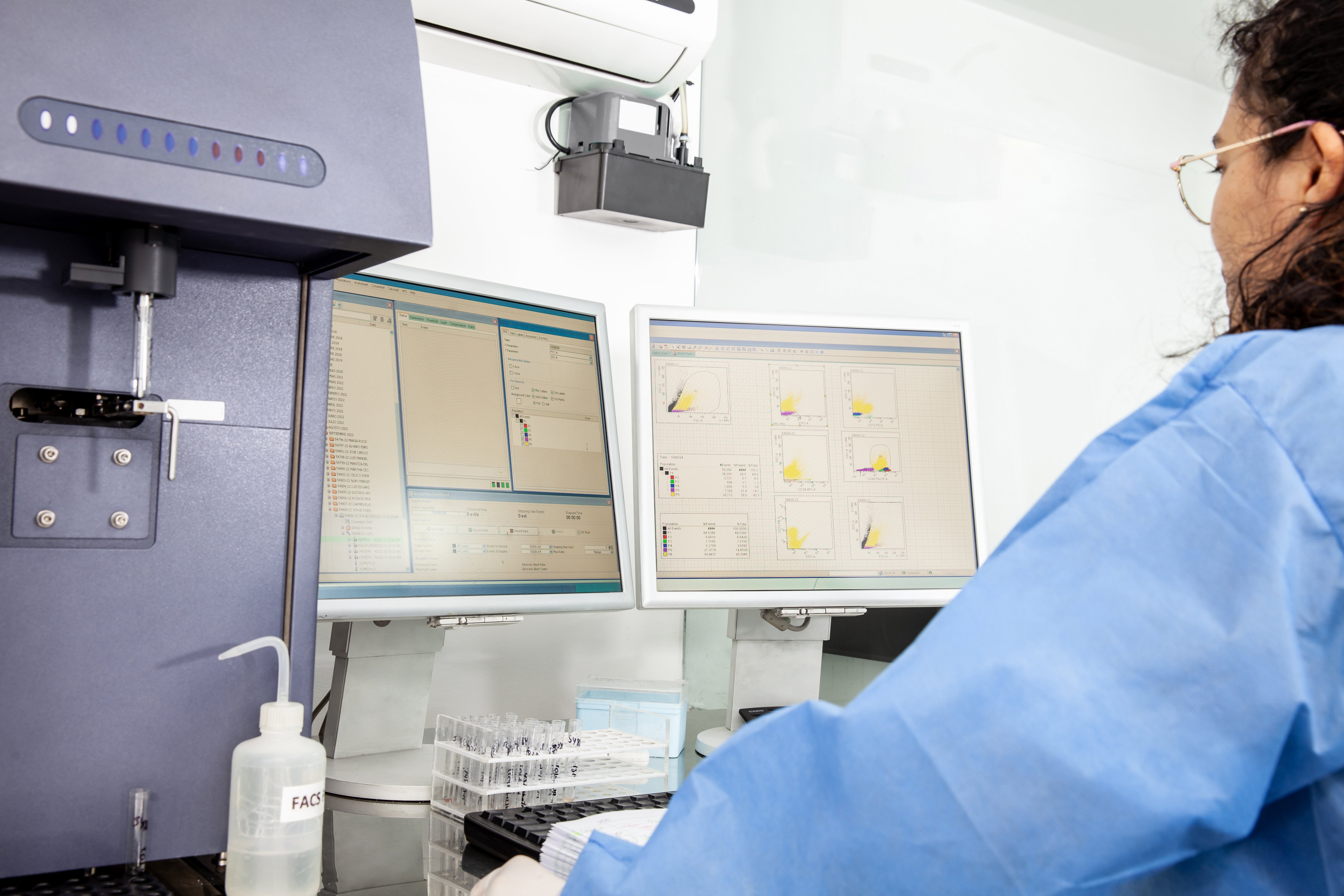
Better Antibodies, Better Results: Optimizing Flow Cytometry Data with Quality Antibodies

The powerful, single-cell resolution of flow cytometry has cemented it as a cornerstone technique across a wide spectrum of research and diagnostic applications. Flow cytometry provides rapid, sensitive detection and quantification of metrics such as cell size, granularity, or specific biomarker expression. By uniting precision and speed, flow cytometry enables users to characterize and sort heterogeneous populations of cells based on structural or functional parameters of interest.
As with any method that employs antibody reagents, flow cytometry performance depends on the use of high-quality, well-validated antibodies. Understanding the technical foundations of flow cytometry and determinants of data quality can guide users in selecting the optimal antibody reagents for their application.
How Is Flow Cytometry Used in the Lab?
As single cells flow in suspension through a laser beam, a flow cytometer detects and measures the light-scattering properties of the cell or, if used, the emitted fluorescence of fluorophore-conjugated antibodies bound to cellular targets of interest. The instrument outputs quantitative, single-cell data for each parameter, allowing analysis of population distributions and marker co-expression.
Using multiple antibodies, each tagged with a distinct fluorophore, enables multiplexed analysis of several markers within the same sample. This is especially valuable in immunophenotyping, rare cell detection, and functional studies where cell states can be defined by marker co-expression.
The Vital Role of Antibody Performance in Flow Cytometry
The research community has long decried the lack of standardized methods for validating the specificity and affinity of antibody reagents.[1] Commercial antibody characterization data are often generated using cell lines engineered to express the protein of interest at levels higher than typical physiological conditions, limiting their validity.[2] Inconsistencies in antibody reagents undoubtedly contribute to widespread challenges with experimental reproducibility and wasted resources.
In flow cytometry, several elements of antibody performance are key to achieving strong, trustworthy data. First, confirming an antibody’s ability to specifically recognize a unique epitope, as well as its potential for cross-reactivity with similar domains of other molecules, ensures an assay accurately measures its intended target. Because cross-reactivity is not always predictable based on sequence analysis and expression of off-target epitopes can vary between analyzed samples, thorough validation that eliminates cross-reactive antibodies is foundational for achieving clear results.
Importantly, antibodies used for flow cytometry must be validated for this specific application. Whereas antibodies used in immunohistochemical assays recognize linear epitopes accessible after protein denaturation, flow cytometry analyzes whole cells and proteins in their native forms. Most antibodies used for flow recognize conformational epitopes, meaning that an antibody that performs well in western blots is likely not suitable for flow.
The growing awareness of antibody validation issues has fueled collective efforts to strengthen and standardize characterization protocols. YCharOS, a knockout-based consensus platform developed through academia-industry collaboration, enables direct comparison of research antibodies across immunoblot, immunoprecipitation, and immunofluorescence methods. The system provides accessible, scalable protocols for antibody characterization studies, as well as open access to in-depth characterization data for antibodies tested thus far.[3]
How to Select and Use the Right Antibodies for Flow Cytometry
In addition to selecting high-performing antibody reagents, understanding optimal use can set experiments up for success. Here are some considerations for getting the most out of your flow cytometry antibodies[4]:
- Pairing of fluorophores and markers requires knowledge of a specific fluorochrome’s brightness and the relative expression level of a marker. Antigens with low population density are best suited for evaluation with a very bright fluorophore to adequately distinguish between weakly positive and negative cell populations.
- Antibody concentration is crucial in obtaining a high signal-to-noise ratio. Performing titration for your specific flow cytometry protocol, cell type, or instrument, as well as for each new antibody lot, can help identify a concentration that maximizes data clarity, minimizes waste, and reduces background staining.
- When expression levels do not clearly delineate cell populations, gating controls can inform your data analysis strategy.
- Fluorescence Minus One (FMO) controls are generated by staining samples with all fluorophores but one used in a multicolor experiment, accounting for spectral overlap in gating
- Isotype controls enable assessment of non-specific binding by employing an irrelevant antibody of the same isotype as the experimental antibody
- Internal negative controls (INC) are cells known to lack the marker(s) of interest, helping to distinguish non-specific binding from target binding
How Aviva Supports Data Integrity and Reproducibility
Enhanced characterization and validation of antibody reagents is not just central to improving experimental reproducibility—it’s a core component of our commitment to supporting scientists across the research spectrum. As a manufacturer, providing better validation data for antibody products in various applications can save researchers invaluable time and resources.
Our commitment to reproducibility begins with our portfolio of recombinant antibodies, which demonstrate lower lot-to-lot variability than conventional monoclonal antibodies. For more extensive validation data on these and other antibody reagents, Aviva Systems Biology combines a stringent in-house antibody characterization program, including surface plasmon resonance (SPR) affinity characterization, with genetic validation through partnership with YCharOS (check out this blog post for more information). Together, these enhanced validation methods enable us to offer a comprehensive catalog of antibodies that deliver reliable performance.
Explore our offerings to empower your flow cytometry experiments with trusted reagents and expert support.
References
[1] Bradbury, A. and Plückthun, A. Reproducibility: Standardize antibodies used in research. Nature 2015; 518: 27-29.
[2] Baker M. When antibodies mislead: the quest for validation. Nature. 2020; 585(7824): 313-314.
[3] Ayoubi, R., et al. A consensus platform for antibody characterization. Nature Protocols 2025; 20(6): 1509-1545.
[4] Maecker, H. and Trotter, J. Flow cytometry controls, instrument setup, and the determination of positivity. Cytometry Part A: the journal of the International Society for Analytical Cytology 2006; 69(9): 1037-1042.


